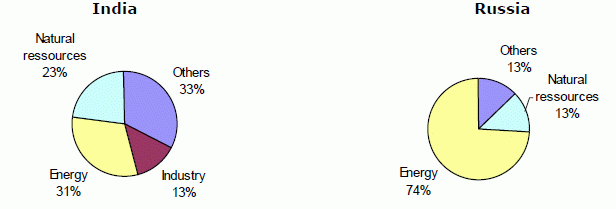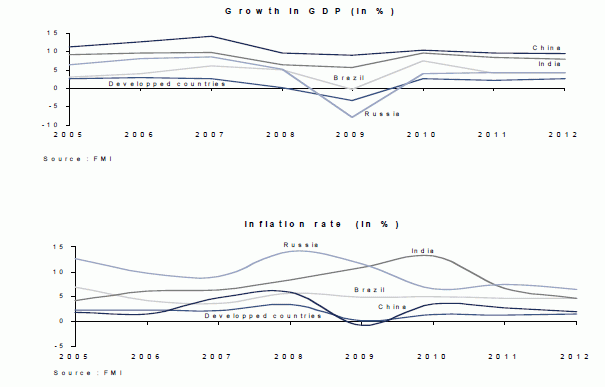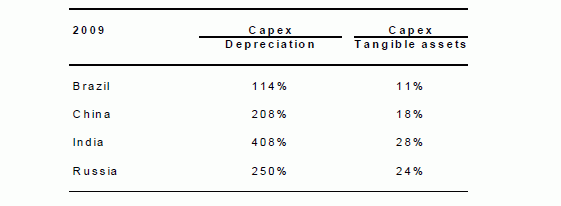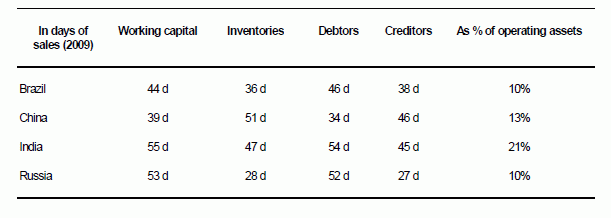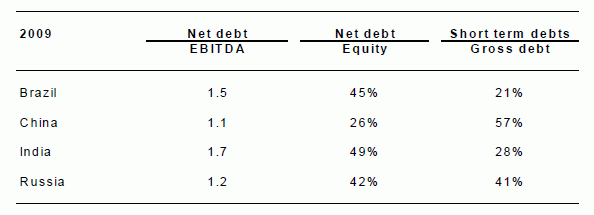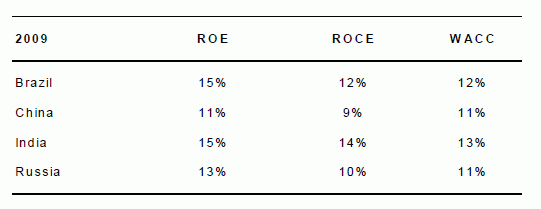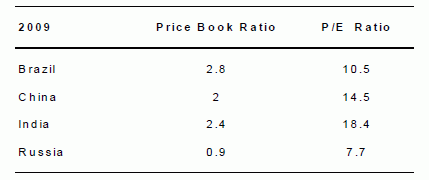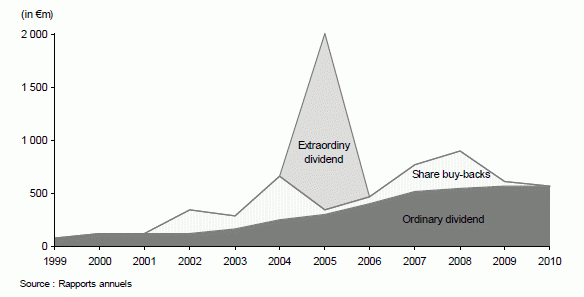Letter number 56 of January 2011
ALL ARTICLES
- TOPIC
- STATISTICS
- RESEARCH
- QUESTIONS & COMMENTS
News : Financial analysis of BRICs
Over the past three years, we have looked at the financial situations of the main listed groups in China (1), India (2), Brazil (3) and Russia (4).
Our studies covered non-financial groups, made up of:
A large portion of the Russian and Brazilian economy is already listed on the stock market, while in India and China, this proportion in twice smaller, which leads us to predict that 2011 will not be the last year for successive IPOs in China.
Activity
The Russian economy is heavily reliant on raw materials and energy, while Brazil, India and China are a lot more diversified:
In terms of growth, Russia is again an exception, recording much lower growth between 2006 and 2009 than its peers (2%). This is explained by the sudden decline (-10%) in 2009, largely caused by oil price performances, given the importance of energy in the Russian economy:
Margins
Margins are much higher in Russia, where competition is not very intensive, and in Brazil, as in these two countries, energy plays a major role and since it is a highly capital intensive sector, margins tend to be higher:
Naturally, we see a fall-off in margins in 2009, but to levels that are not at all worrying. For comparative purposes, in 2009, the EBIT / sales ratio of listed European groups was around 9%, with expectations of 12% for 2010.
It does not escape our notice that China, the world’s workshop, has the lowest margins.
Capital expenditures
These are naturally relatively high, given the growth rates in volume:
In terms of working capital, the BRICs still have a lot to learn but it is difficult to excel simultaneously at all of the criteria! And when growth is being recorded, management of working capital often ranks lower on the priorities list.
Financing
An overall moderate level of debt, but there is too much short-term debt in China and Russia, probably the result of poor protection of lenders and / or a limited trust in the published accounts:
Returns
On average, Chinese groups earn less than their cost of capital and not just in 2009 which was a bad year (5). The same applies to Russian groups, although the gap is smaller, and it is limited to 2009. In 2007 and 2008, they earned around 17% on their capital employed.
Valuation and conclusion
Brazil has some characteristics that are similar to those of developed countries: high dividend rates, positive free cash flows, less growth except for valuation parameters: strong P/B ratio.
China is growing fast but is not posting high enough returns, and is thus generating negative cash flows, which are covered by short-term debt. If this is not corrected over the next few years, there is a risk of stock market investors being seriously disappointed.
India is growing and accumulating debts.
Russia creates high value on paper, but Russian groups are not highly valued (P/B ratio of 0.9), probably because of the high risks in the country (and not only climate-related risks!), weak corporate governance and margins that are likely to decline with the development of competition.
(1) For more details see Vernimmen.com Newsletter n° 29, Decembre 2007.
(2) For more details see Vernimmen.com Newsletter n° 40, March 2009.
(3) For more details see Vernimmen.com Newsletter n° 52, September 2010.
(4) For more details see Vernimmen.com Newsletter n° 54, November 2010.
(5) For more details see Vernimmen.com Newsletter n° 29, Decembre 2007.
Statistics : A distribution policy example: Bouygues
Bouygues policy for returning funds to shareholders, in the broad sense of the term (ordinary dividends, extraordinary dividends, share buy-backs) provides a good illustration of what these three tools are used for:
The ordinary dividend is intended to be recurrent because shareholders expect it and because companies know how costly it can be if they let shareholders down in this regard.
The extraordinary dividend, as the name indicates, is intended to return extraordinary amounts of cash to shareholders, most often following the sale of a large assets, as Bouygues did following the sale of a subsidiary (Saur) in 2005.
Share buy-backs are intended to return to shareholders, cash flow that is temporarily excessive over several years. Because of its temporary nature, even if spread over several years, it is not possible to increase the dividend as it may no longer be possible to finance it once the transitory cash flow has dried up, and as it is spread over several years, its annual amount is insufficient to make up an extraordinary dividend.
For more information, see chapter 38 of the Vernimmen.
Research : The real effects of corporate cash
Traditionally, research into corporate finance has not paid much attention to the issue of cash reserves (simply perceived as a negative debt).
Nevertheless, since the late 1990s, different research has shown that large groups often have very substantial amounts of cash, representing on average between 15 and 20% of assets (as much as 25 to 30% just before the crisis in the United States). This figure has changed significantly since the 1970s, and at that time it barely reached 10%. More recently the economic crisis and the problems of access to liquidity that it resulted in have also raised interest in the issue of cash reserves. What is the advantage for companies of having large reserves of cash? Laurent Frésard brings an original response to this question, showing that cash can be a real strategic tool in environments that are highly competitive (1).
Frésard studied the effect of cash reserves on the strategy of over 5,000 US firms. To do this, he linked the cash reserves of a firm (relative to the average levels of those of its main competitors), to the future evolution of its market share.
Frésard is also interested in the link between the relative level of cash reserves and the market value of the firm, measured thanks to the market-to-book ratio. Data is extracted from Compusat and covers a period running from 1973 to 2006.
Changing our view of cash reserves
For a long time, abnormally large cash reserves were seen as being a very bad thing. They were suspected of providing managers with too much latitude for action, at the expense of shareholders (2). Combined with inadequate governance, such reserves could be used for financing projects that would benefit managers more than shareholders. However, more than a risk, Frésard sees such cash reserves as a real strategic tool. Especially in times of crisis, because they do not need to rely on the capital markets for financing their activities, firms with large cash reserves perform better than their competitors.
Cash reserves – more than just a safety net
But are cash reserves just a safety net in periods of economic crisis? "Not only", says Frésard, who explains that they also play an important role in the long-term performance of the firm. He draws our attention to two effects:
• A company with large cash reserves has more flexibility in terms of strategy. In a very competitive environment, such cash will enable it to lower its prices, to offer its customers better service, to hire talented employees or to improve its distribution network. These short-term sacrifices will enable the company to create a dominant position on the goods and services market and thus to improve its long-term performance.
• Additionally, a repelling effect may be felt. A firm’s strategy could be influenced by the level of its competitor’s cash reserves. For example, explains Frésard, the decision on whether or not to enter a new market or to launch a new product is undeniably influenced by the fire power of potential competitors.
Impact of cash reserves on market share
Frésard looked at how a firm’s cash reserves (analysed on the basis of the average cash reserves of its competitors) impact on its results in terms of market share. He shows that on average, holding an additional unit of cash compared with its main competitors, will result in an increase in market share of close to 3% over the following two years. A more detailed analysis of results shed light on factors that increase this strategic effect:
• competitors’ financing problems: the effect is increased by two or three times when competitors experience difficulties in finding funds;
• nature of the competition on the market: the more competitive the market (large number of players), the greater the effect;
• technological proximity: he also shows that the effect is greater between companies that are close in technological terms.
Effect of cash on the value of the firm
Although Frésard shows that having cash reserves has a positive impact on a firm's market share, it still has to be shown how the market values this strategic dimension.
Frésard reminds us that a rapid increase in market share is not necessarily a positive thing for the company. He nevertheless shows that one fraction of additional cash held by a firm results in a market value that is 6% higher than that of the firm’s competitors. This phenomenon seems to have been amplified recently with the financial crisis, and creates the impression that investors value the strategic dimension of cash very positively.
(1) Financial Strength and Product Market Behavior: The Real Effects of Corporate Cash Holdings, Journal of Finance, June 2010, volume 65, n° 3, pages 1097 to 112.
(2) For more information, see chapter 34 of the Vernimmen.
Q&A : Why successfull group have so low a debt level?
When we look at the capital structure of the international groups that are the most successful, we are struck by how little debt they are carrying:
• the 35 international listed groups with a market capitalisation of over €40bn and a P/B ratio of more than 3, with a high level of value creation, have an average debt/EBITDA ratio of 0.1. Apple’s is - 1.7, L’Oréal’s 0.6 and Coca Cola 0.3.
• the 50 international groups considered to be the most attractive employers, excluding financial and unlisted groups, have a Debt/EBITDA ratio of 0.6.
Capital structure is first and foremost a choice made by shareholders, as they are the ones that will directly suffer the consequences thereof. This choice will depend on how high or low their risk aversion is. Some investors only have a moderate appetite for risk and do not wish to add a capital structure risk to the company's operating risk. Others, however, are prepared to take on more risk, even going as far as an LBO.
From a theoretical point of view, the statement by Franco Modigliani and Merton Miller in 1963 (debt makes it possible to lower the cost of capital and hence to maximise the value of equity) has long since been refuted, even by themselves: Merton Miller in 1977, then in 1998, with confirmation that the value of capital employed is impervious to the capital structure of a firm (1).
Incidentally, the most recent research (Laurent Frésard, 2010, see previous article) shows that firms with cash resources win market share from their competitors that do not have such cash reserves.
Does anyone need reminding that LVMH has, since 2008, apparently been able to get hold of 20% of Hermès shares, a company that it has long been coveting, thanks to its lack of significant debt (Debt/EBITDA ratio of 0.9) and its large cash pile, enabling it to be strategically agile and thus to create value?
(1) For more information, see chapter 34 of the Vernimmen.


